St. Paul, Minnesota, was buzzing on 14 March 1884 because an unusual and very important visitor had arrived: Sitting Bull, a chief and holy man of the Hunkpapa Lakota Indians, wanted to see firsthand a large city and the ways of the whites.
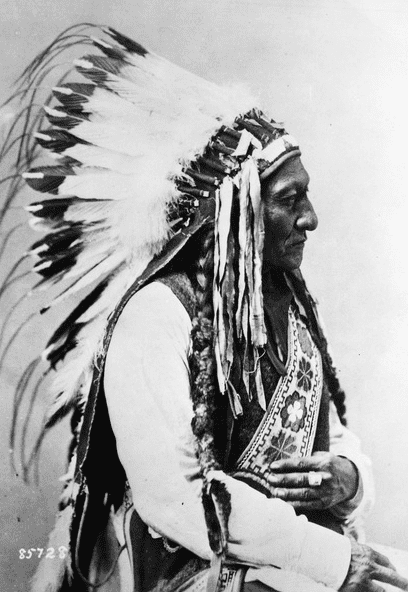
Once a powerful warrior and a fierce defender of his people and their land, Sitting Bull had been one of the principal leaders of the large encampment of Lakota and Cheyenne that George Armstrong Custer attacked on 25 June 1876. That ill-fated attack cost Custer his life, along with 267 of the men he led that day.
Despite the victory over Custer, most of the Indians involved in that fight had surrendered and accepted reservation life within a year of the Battle of the Little Big Horn – but not Sitting Bull. He led his band into the safety of Canada in May 1877. Four years later, however, destitution and hunger drove them to finally give up, and Sitting Bull and his people returned to the U.S. and surrendered on 19 July 1881. On 10 May 1883, they were transferred to the Standing Rock Agency, and tried to adapt to reservation life.
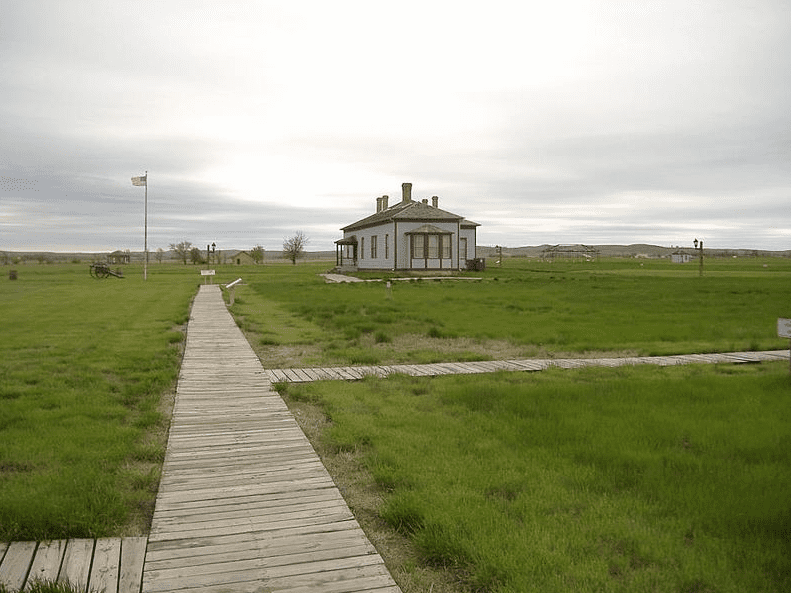
After a lifetime of hunting and freedom on the plains, Sitting Bull reluctantly adopted a farming lifestyle confined on a reservation. By all accounts a wise and thoughtful man, Sitting Bull wanted to learn more about this race of people that had conquered his own. And so it was that in the spring of 1884, upon learning that Indian Service agent James McLaughlin was going to St. Paul, Minnesota, on business, Sitting Bull asked to accompany him. McLaughlin, a firm believer that the Indians had to adopt white ways or perish, agreed to take Sitting Bull along to educate him in the ways of “civilization.”
They were the toast of the town from the day they arrived in St. Paul. Sitting Bull toured factories, schools, and government offices – even going to the theater. He witnessed many of the marvels of the age, such as the impressive printing presses in action at the Pioneer Press, and used the telegram and made a telephone call. He watched a demonstration put on by the fire department, springing into action at the urgent calling of a fire alarm. He walked the streets and stared up at the large buildings.
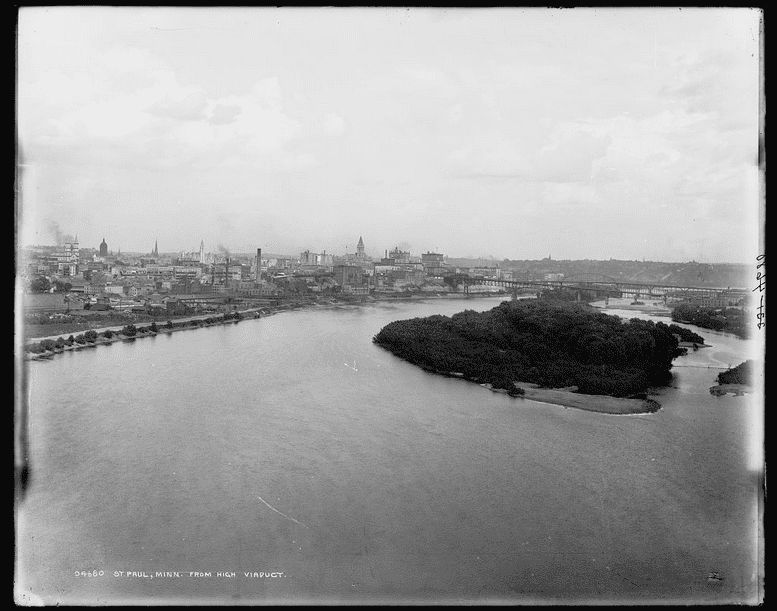
The following is a series of newspaper accounts of Sitting Bull’s visit to St. Paul in 1884. They tell us something about the man himself, but more often reveal attitudes of the white society that received and perceived him. What we will never know is what exactly was going on in Sitting Bull’s mind as he saw the power and strangeness of the new world being created by the whites.
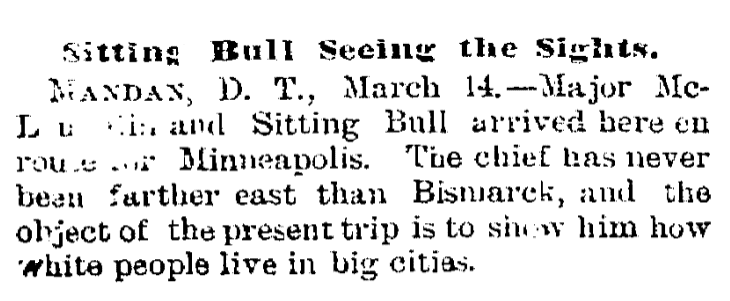
Here is a transcription of this article:
Sitting Bull Seeing the Sights.
MANDAN, D.T. [Dakota Territory], March 14. – Major McLaughlin and Sitting Bull arrived here en route for Minneapolis. The chief has never been farther east than Bismarck, and the object of the present trip is to show him how white people live in big cities.
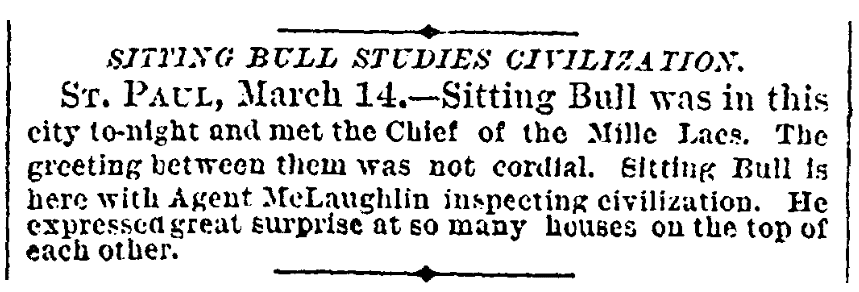
Here is a transcription of this article:
SITTING BULL STUDIES CIVILIZATION.
ST. PAUL, March 14. – Sitting Bull was in this city to-night and met the Chief of the Mille Lacs. The greeting between them was not cordial. Sitting Bull is here with Agent McLaughlin inspecting civilization. He expressed great surprise at so many houses on the top of each other.
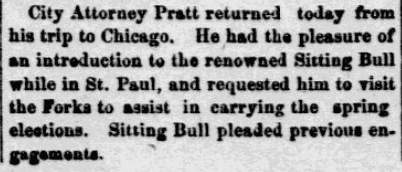
Here is a transcription of this article:
City Attorney Pratt returned today from his trip to Chicago. He had the pleasure of an introduction to the renowned Sitting Bull while in St. Paul, and requested him to visit the Forks to assist in carrying the spring elections. Sitting Bull pleaded previous engagements.
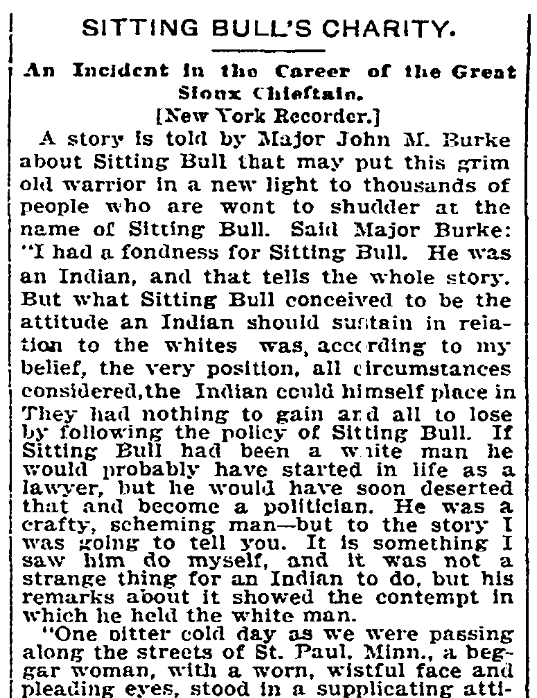
An incident from Sitting Bull’s St. Paul visit reveals much about his character. It was told by a Major Burke in 1894, four years after Sitting Bull was murdered by Indian police sent to arrest him by the same agent McLaughlin who, along with Major Burke, had accompanied Sitting Bull as he strolled the streets of St. Paul back in 1884. This article was published by the New York Recorder and reprinted by the Kansas City Times. Here is a transcription of this article:
SITTING BULL’S CHARITY.
An Incident in the Career of the Great Sioux Chieftain.
A story is told by Major John M. Burke about Sitting Bull that may put this grim old warrior in a new light to thousands of people who are wont to shudder at the name of Sitting Bull. Said Major Burke: “I had a fondness for Sitting Bull. He was an Indian, and that tells the whole story. But what Sitting Bull conceived to be the attitude an Indian should sustain in relation to the whites, was, according to my belief, the very position, all circumstances considered, the Indian could place himself in. They had nothing to gain and all to lose by following the policy of Sitting Bull. If Sitting Bull had been a white man he would probably have started in life as a lawyer, but he would have soon deserted that and become a politician. He was a crafty, scheming man – but to the story I was going to tell you. It is something I saw him do myself, and it was not a strange thing for an Indian to do, but his remarks about it showed the contempt in which he held the white man.
“One bitter cold day as we were passing along the streets of St. Paul, Minn., a beggar woman, with a worn, wistful face and pleading eyes, stood in a supplicating attitude, her thin, blue hands outstretched for alms, while the cruel winds that were whistling around the corner whipped her thin clothing with cruel cracks. Old Sitting Bull looked stolidly at the woman for a few seconds, grunted “Ugh!” then he fumbled inside the folds of his big, warm, red mackinaw blanket, brought forth from the place where no one but an Indian could carry it, a handful of silver, at least $10, dropped all of it in the woman’s shivering hand and passed on.
“I said to him, ‘Bull, you must not do that! You should not give your money away like that!’
“Said the old savage, ‘Ugh! White man build heap big wigwam!’ and he pointed to the towering walls around us. ‘White squaw heap cold, heap hungry; white man heap no good.’”
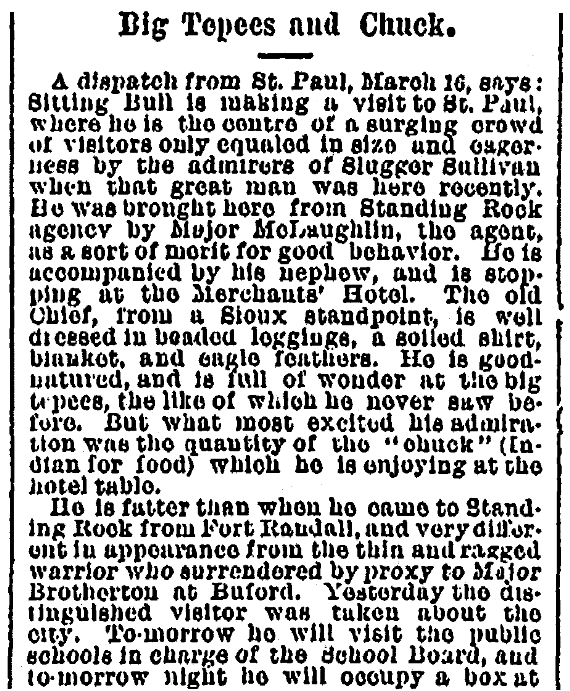
Here is a transcription of this article:
Big Tepees and Chuck.
A dispatch from St. Paul, March 16, says: Sitting Bull is making a visit to St. Paul, where he is the centre of a surging crowd of visitors only equaled in size and eagerness by the admirers of Slugger Sullivan when that great man was here recently. He was brought here from Standing Rock agency by Major McLaughlin, the agent, as a sort of merit for good behavior. He is accompanied by his nephew, and is stopping at the Merchants’ Hotel. The old Chief, from a Sioux standpoint, is well dressed in beaded leggings, a soiled shirt, blanket, and eagle feathers. He is good-natured, and is full of wonder at the big tepees, the like of which he never saw before. But what most excited his admiration was the quantity of the “chuck” (Indian for food) which he is enjoying at the hotel table.
He is fatter than when he came to Standing Rock from Fort Randall, and very different in appearance from the thin and ragged warrior who surrendered by proxy to Major Brotherton at Buford. Yesterday the distinguished visitor was taken about the city. To-morrow he will visit the public schools in charge of the School Board, and to-morrow night he will occupy a box at the Grand Opera House.
The chief and his nephew visited the Pioneer Press office, and were surprised, though they didn’t show it, by the telegraph, telephone, fire alarm gong, steam heaters, etc. The chief sent a telegram to his son in Chicago, saying that he had been sick but was much better, and received an answer right away. The telephone broke him all up and forced the first exclamation from him, and he laughed for the first time in many moons. The nephew was placed at an instrument in one room and Sitting Bull in another room, 100 feet distant. The chief listened, started, grinned, and then exclaimed, “Waukan!” (evil spirit). In the composing room, an accommodating proof-taker took proofs of various millinery cuts and other pictures, which elicited grunts of satisfaction from the old chief, and he carried off the pictures as great prizes.
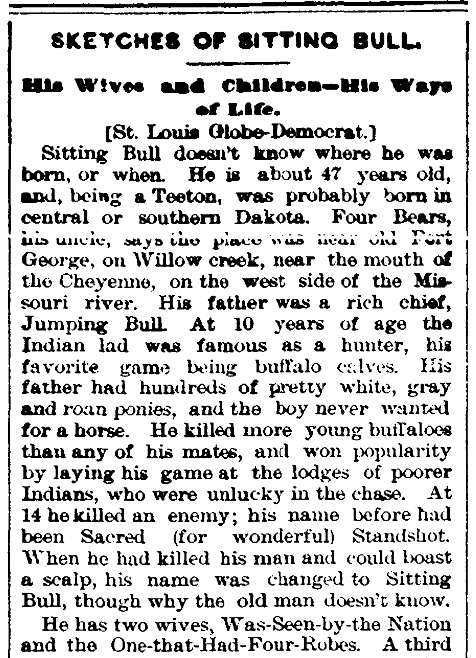
With interest in Sitting Bull growing, the St. Louis Globe-Democrat published a biographical article about the chief. It was reprinted by the Trenton Times. Here is a transcription of this article:
SKETCHES OF SITTING BULL.
His Wives and Children – His Ways of Life
Sitting Bull doesn’t know where he was born, or when. He is about 47 years old, and, being a Teton, was probably born in central or southern Dakota. Four Bears, his uncle, says the place was near old Fort George, on Willow creek, near the mouth of the Cheyenne, on the west side of the Missouri river. His father was a rich chief, Jumping Bull. At 10 years of age the Indian lad was famous as a hunter, his favorite game being buffalo calves. His father had hundreds of pretty white, gray and roan ponies, and the boy never wanted for a horse. He killed more young buffaloes than any of his mates, and won popularity by laying his game at the lodges of poorer Indians, who were unlucky in the chase. At 14 he killed an enemy; his name before had been Sacred (for wonderful) Standshot. When he had killed his man and could boast a scalp, his name was changed to Sitting Bull, though why the old man doesn’t know.
He has two wives, Was-Seen-by-the-Nation and the One-That-Had-Four-Robes. A third wife is dead. His children are all bright, handsome boys and girls, nine in number; one, a young man about 18, is in a Catholic school near Chicago. Sitting Bull himself is not a Catholic, as reported, nor is it likely that a man of his strength of mind will ever renounce the mysteries of his own savage religion, in which for so many years he has been a powerful high priest. One little boy, 6 years old, bright as a dollar and with eyes that fairly snap like whips, was with him at Buford when he surrendered. At the formal pow-wow the chief put his heavy rifle in the little fellow’s hands and ordered him to give it to Maj. Brotherton, saying: “I surrender this rifle to you through my young son, whom I now desire to teach in this way that he has become a friend of the whites. I wish him to live as the whites do and be taught in their schools. I wish to be remembered as the last man of my tribe who gave up his rifle. This boy has now given it to you, and he wants to know how he is going to make a living.” Happily, Sitting Bull’s anxiety for his children is being grandly met in the work of the Carlisle and Hampton schools and the gradually enlarging schools and academies planted by the missionaries throughout Dakota and the West.
Sitting Bull is a typical Indian. He is wide between the cheek bones, which are more than ordinarily prominent. His chin is sharp and long, and his mouth and dark eyes betoken great firmness of character. His dress is like that of any other half-civilized red man. He affects little silly ornaments that make his grim dignity very laughable. His voice is a deep, gruff bass. He shuffles along as he walks, stepping on the outer edge of the left foot, which was badly wounded years ago. The old man will live a good many years if smoking does not use him up. He got his first glimpse of civilization last winter, coming to St. Paul with Agent McLaughlin. The thing that struck him most forcibly in his travels was the ballet which he saw at one of the theatres. This is not remarkable, as Indian women are never known to display their bodily charms as do the females of a superior race. This indecency, however, Sitting Bull looks upon as one of the supreme evidences of our greater civilization. Maj. McLaughlin says he would talk of nothing else on the way home. His great ambition in life now is to get a white wife. He says he would give two ponies for a ballet girl.
Note: An online collection of newspapers, such as GenealogyBank’s Historical Newspaper Archives, is not only a great way to learn about the lives of your ancestors – the old newspaper articles also help you understand American history and the times your ancestors lived in, and the news they talked about and read in their local papers.
Related Articles:
